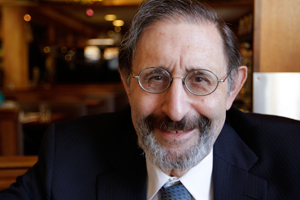Interview: David Drew on Broadening STEM Education & Debunking Its Myths
By Wired Academic on January 25, 2012
Domestic, Education Quality, Faculty, Interview, K-12, Private, Public, Regulatory, Required, STEM, Universities & Colleges
David Drew, a professor and former dean at Claremont Graduate University who has studied science, technology, engineering and math (STEM) education for decades, recently wrote the book Stem the Tide: Reforming Science, Technology, Engineering and Math Education in America. STEM has been a central focus of education reform by President Barack Obama. The Hechinger Report sat down with Drew to hear how those reforms are progressing and what he learned while researching his book.
I totally agree with the first one. I believe what they’re saying is there are many people who could succeed who get discouraged from STEM or never encouraged, which is the main thrust of my book. I feel that often that happens because teachers and counselors—and sometimes even parents—believe that a girl can’t do math, believe that a student of color can’t master math and science, that a white student from poverty cannot become a scientist. All of these are false beliefs. That’s all garbage. The whole thrust of my book is that in the emerging high-tech global economy, we switch from the manufacturing era to the information era, and pretty much everybody should be learning at least some of this in high school and many people could go into STEM as a career. We have to get away from a model from the industrial age that says: a) we only need a few people in this area and those will be the geeks; and b) only a few people can succeed in this area. Those are false. So my whole book is about broadening participation, and I feel the achievement gap is based on false factors and can easily be eliminated.
So how can we broaden access to STEM education?
I list four factors in the book and talk about a number of programs that have done this. One, recruiting into STEM, which maybe isn’t the best verb because it sounds like marketing. It’s making young people aware that college is an option for them and STEM is an option for them. Two, mentoring is critical. Three, in high school and in college, finding ways to create study groups and peer support groups that are focused on academic excellence. The main thing is not to discourage kids and to encourage them to study STEM. Some of the key decisions occur in middle school because they’re heading into algebra. I used to work with Carl Sagan and one of the things we struggled with is that kindergarten students and first-grade students have a natural interest in science and they’ll ask questions about it and get involved, but then if you look as they get older, their interest declines. Where it becomes critical is in middle school because there students are making choices about what they will take in high school and that affects whether they will go to college and where they will go to college. A lot of the avoidance of STEM by teachers, counselors, parents—steering students away from STEM, or avoidance by the students themselves—has to do with anxiety about math. What you have to do is get beyond psychological barriers to broaden participation.
President Obama has made advancing STEM education one of the centerpieces of his education reform vision. From your perspective as someone who has studied it extensively for decades, have the changes he has begun to implement been making a difference? Are they changing things on the ground?
Yes, but I don’t think it’s enough. I understand that there are constraints. I also think that there are some myths that everybody buys into when talking about reforming education. There are four. Here’s something you’ll hear high officials in government saying: ‘American high-school students perform dismally in international assessments.’ Which is true. ‘This shows how much American education has declined. We have to take steps to restore American secondary and elementary education to its former glory and here’s how I think we should do it.’ That’s false. There was no period of former glory. We always were at the bottom. Now it’s become much more important, and we’re more aware of it now. Another myth is that the way to fix this is to spend a lot on curriculum. I don’t think so. Curriculum reform is fine, but we’ve spent huge sums—for example, the new math after Sputnik. Given the choice, I’d rather have my child taught by an exciting, creative, involved teacher using a science curriculum from the 1950s, as contrasted with a hostile, critical, boring teacher using the latest curriculum. I think it’s all about the teacher. Another myth is that the key is we’ve got to recruit more young people into teaching. That’s good, but it’s not the key in my opinion. The problem isn’t getting young people into teaching; it’s keeping them in teaching. But it’s all about the teacher.
There’s a program that started here in New York that I think is an excellent model for how to fix [STEM education]. In complex systems, you look for a leverage point where a little investment of energy or money can make a difference. This is my idea of the key leverage point for STEM education. A man named James Simons made a couple billion on Wall Street, and he decided that he wanted to do something about the weakness of math education in the U.S. So he started a program called Math for America in New York City initially. He said, we’re going to pick out outstanding graduates from undergraduate programs who majored in math. If they will commit to at least six years teaching in an under-served school, we will do the following: we’ll pay for their master’s degree in education so they get instruction on how to teach [and] for the first six years that they’re teaching, we’ll give them a salary bonus of $20,000 a year. It can be transformative. And this was done with private funds. He put in $50 to $100 million of his own money. I think this is the way to go … What if we established a program in math—there are about 250,000 math teachers across the country—what if we said we were going to reward the top 100,000? Setting aside for a moment the issue of exactly how that would be measured, with $20,000 a year extra. And what if that money came from the federal government or a government/corporate combination? Then you’d have people trying to be better and better. That’s a big incentive. And given that part of the background of this is that teaching is not rewarded, nor is it respected enough in this country compared to other countries where the students outperform ours. I’d like to elevate the whole profession.
The general conversation about STEM seems to be that America is falling behind, and it’s repeated over and over again that ‘we’re in a knowledge economy and in order to compete with other countries in twenty-first century jobs, we need more people studying STEM and going into STEM careers.’ That’s the common conversation today, and most people buy into that. You’ve compiled all the latest research in your book, so I wonder: 1) if that’s true; and 2) are there things in your book that might surprise people and change that conversation? Or is that the right conversation to be having?
That is the right conversation to be having. There are things that would surprise people. I think the fundamental barrier is that people are worried about erroneous beliefs that some students may not be up to it. And I feel that virtually any student can master these subjects, at least at the high-school level, and many in college. As far as surprises, many students can benefit from technical training—community college technical training. There are many STEM jobs that don’t require a college degree. I am not saying that some students are not smart enough to go to college—my whole bid is that everyone can learn this—but some students don’t want to go to college. Some want to go to work right now. So take STEM courses in high school and some community-college courses, and there are jobs that are in demand now such as underwater welders, all kinds of jobs where you can get excellent training. I also don’t think enough attention is paid when discussing STEM [in relation] to reading. I haven’t ever met an outstanding mathematician that can’t read. I think there are still a lot of uninformed ideas and prejudices that certain people can’t do this. And that’s just wrong. When you have the president of Harvard saying that women maybe don’t have the intellectual fire power to succeed in STEM, that’s pretty serious. It’s a battle that I feel is the central battle, and I think we’re in an era now with respect to women in STEM, with respect to underrepresented minorities in STEM, with respect to white students from poverty in STEM, that’s kind of like a previous era with respect to civil rights where the rhetoric was one thing but the reality was different.
Related Posts


Tips & Pitches
Latest WA Features
-
Online Courses Are Expanding, Along With Questions About Who Owns The Material
-
Why Size Matters: Consolidation Sweeps Across US Higher Ed
-
Trend: Corporate U Employers Offering Just In Time Education To Workers
-
Subterfuge & Skullduggery In The College Rankings Game
-
“Instreamia” Shakes Loose Moss By Launching Spanish Language Mini-MOOC
Domestic, Education Quality, For-Profit, Friend, Fraud, or Fishy, K-12, Legislation, Opinion, Personalized Learning, Regulatory, Required, Universities & Colleges - Apr 29, 2014 - 0 Comments
Michael Horn: NCAA March Madness Followed By April Blunder In Online Learning
More In For-Profit
- The Economy Is Forcing Tuition To Fall Rapidly At Private, For-Profit Colleges
- Kamenetz: Jeb Bush As Controversial Leader Of Aspen Task Force on Learning & The Internet
- Columnist Ryan Craig: The Best Of Times Could Return As For-Profit Edu Invests
- Bubble Analysis: Trace Urdan on Why This Era of Ed Investing Could Be Different
- A Blended Path? How American Honors Cuts Cost of Four Year Degree by Over a Third
Community Colleges Cost of Education Domestic For-Profit Required Student Loans Universities & Colleges
Blended Learning, Domestic, Education Quality, Gamification, K-12, Open Source Education, Required, Startups, Technology - May 22, 2015 - 0 Comments
iCivics: Video Games as Middle School Social Studies Curriculum
More In Technology
- Online Education As A Postmodern Societal Response
- MakerBot Academy: A 3-D Printer In Every Classroom
- Michael Horn: A Look Behind The Curtain At How A MOOC Is Made
- Koller, Khan and Agarwal At The NYT’s Schools of Tomorrow Conference
- Video: New NESTA Report, Three Steps To Assess Digital Innovation in Education
Domestic, Education Quality, For-Profit, Friend, Fraud, or Fishy, K-12, Legislation, Opinion, Personalized Learning, Regulatory, Required, Universities & Colleges - Apr 29, 2014 - 0 Comments
Michael Horn: NCAA March Madness Followed By April Blunder In Online Learning
More In Friend, Fraud, or Fishy
- Online Education As A Postmodern Societal Response
- Apple Tightens Its 94% Choke-hold On The Education Tablet Market
- Michael Horn: Why Obama’s Proposals Won’t Entirely Revolutionize HigherEd
- Columnist Ryan Craig: The Curious Case Of HigherEd Accreditation
- McGraw-Hill Executive Speaking About Big Data: “Don’t look at us, look at Joe Camel”
Domestic Ebooks Education Quality Ereaders Ethics Friend, Fraud, or Fishy K-12 Publishers & Curriculum Required Textbooks







Reply